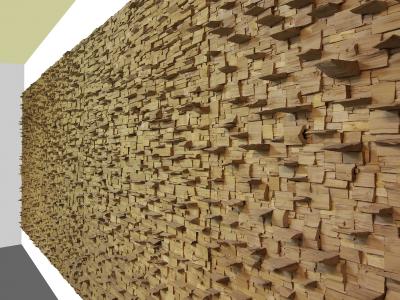Jan de Weryha-Wysoczański
Mediathek Sorted






































































































But even in this case, individual strands of tradition retain their significance. While the Americans derived Minimal Art from, amongst others, Constantin Brâncuși's "Endless Pillar" and thus from Constructivism, Europeans see it in the tradition of Concrete Art. In any case, the transitions are fluid: Max Bill's "Gates" and "Pavilions" derived from Concrete Art and made of layered granite blocks since the 1980s could just as easily be assigned to Minimal Art. The same applies to the memorial that de Weryha erected in 2012 in memory of the forced labourers during the Nazi regime who worked in the Bergedorf district of Hamburg (ill.72a). The cuboid concrete pedestal objectifies commemoration in the form of a minimalist, geometric form lacking any narrative character. In this way it is similar to the "Black Form" erected by Sol LeWitt in Hamburg in 1987, a horizontal black cuboid made of aerated concrete blocks and dedicated to the memory of the Jewish community in Hamburg-Altona who were annihilated by the National Socialists. De Weryha, however, added an interactive element to his monument that conflicts with the classification of Minimal Art: a viewing slit containing a facetted stainless steel cylinder that often breaks the view of the environment behind it. He thereby symbolised the restricted view of the forced labourers held captive under inhuman conditions and added a level of experience to the objective remembrance (ill. 72b).
The intensification of the senses, the sharpening of sensibilities for the phenomena inherent in the material that is decisive for de Weryha, has been observed in Post Minimal Art artists since the late 1960s. Richard Serra, for example, hurled liquid lead into the corners of rooms in order to make the transformation and presence of the material in the physical process visible by means of the solidified blocks. Similarly, de Weryha places and layers split pieces of wood, branches, and bark in corners, along walls, and around pillars (ill. 7, 54, 55, 65). This dynamic form makes it possible for us to experience the working process and appreciate the natural product with every single carefully placed part. Following the example of Barry Flanagan, (one thinks of his "Four Rahsb" and "Four Casb" filled with sand), de Weryha designed conical amorphous monoliths, which he cut out of wood (ill. 1, 12, 20, 21). Like Ulrich Rückriem, who worked with dolomite and granite blocks, de Weryha sawed his forms apart and reassembled them flush.
Rückriem, one of de Weryha's most admired sculptors,[6] exposed the inner structure of the stone with simple, but logically and systematically tested procedures like drilling, fracturing, sawing and splitting. De Weryha claims that his work is similarly based on “three pillars: cutting, breaking and splitting. Terms like rhythms, tensions, dimensions, density and structure are constantly present.”[7] But there are still fundamental differences. While Rückriem moved the split and broken individual parts so closely together that the mass of the stone could still be experienced, de Weryha has concentrated on the many different processes involved in working with wood. With broken edges he creates dramatically moving surfaces (ill. 69, 80, 90) and internal structures (ill. 82, 84, 87-89) and exemplifies the behaviour of the material by breaking and splitting it in each individual module. In his most recent "Wooden Panels", he moves the clefts so far apart that graphic structures are created and insights into the inner structure of the modules are possible (ill. 75, 78, 79, 91, 92). "In my wooden objects," says de Weryha, "there are no stories, no interpretations can be applied to them. They are clean and clear, it is only about the materiality of the wood".[8]
In Poland, the use of wood and other natural materials in modern sculpture and object art has its own tradition. From 1960 onwards, the National High School of Artistic Techniques in Zakopane (Państwowego Liceum Technik Plastycznych w Zakopanem), rediscovered and passed on traditions from folk art. On this basis, Antoni Rząsa, Stanisław Kulon and Józef Kandefer created wooden figurative sculptures that took up expressionist or cubist tendencies once again. Adam Smolana, de Weryha's teacher, abstracted body forms and, like Henry Moore, assembled them into larger masses. Władysław Hasior, also a student in Zakopane, worked with found objects made of wood and created surrealistic compositions from them. Since 1960, Jerzy Bereś, who trained in Krakow, has designed objects made of raw hewn wood, jute ropes, stones, leather, and cloth reminiscent of primitive peasant artefacts and which conjure up ethnological traditions and archaic myths.
[6] Jan de Weryha in an interview „Offenbarungen in Holz“ with Mariusz Knorowski 2006 (exhibition catalog Jan de Weryha-Wysoczański. Objawienia w drewnie, Orońsko 2006, p. 6/10); extracts available online http://www.kultura-extra.de, third last paragraph
[7] online-interview with Helga König, 2015, http://interviews-mit-autoren.blogspot.de/2015/03/helga-konig-im-gesprach-mit-dem.html
[8] ibid





















































































